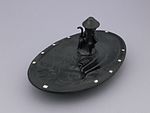kwa.a kiihlaa (Dish)
About this object
Narrative
The Haida stories of Raven Who Kept Walking include the time this trickster-transformer bird fooled a whale into swallowing him whole, only to end up feasting on the whale himself, from the inside out. Once escaped, the Raven inadvertently bit onto a fisherman’s hook, and had his upper beak torn off as he struggled to be free. Later, he put on the skin of an old man to disguise himself, and tricked the people who had cut up the whale’s carcass to flee their village, thereby leaving him to finish devouring it. These episodes – which have multiple versions according to storyteller and context, as well as in the way they were eventually written down by linguists and ethnographers – appear to be part of what Edenshaw captured here, with some ambiguity, in black stone. Depicted in low relief on the surface of the dish may be the moment of the killer whale swallowing the Raven.
Iconographic meaning
Depiction of Raven in human form; dish has imagery of a whale swallowing Raven.
Physical description
Argillite dish, or carving. The sculpted figure that rises from the low relief design looks human, in a state of partial transformation, with feathers on his face and shoulders, and tail feathers down his back. He wears a spruce-root hat and holds a cane with his right hand, covers his chin with his other hand. Decoration on the dish represents a killer whale and raven spread out under the canoe at the bottom of the bay. Their heads are at the opposite end to that of the fisherman with the raven's head in the whale's. The whale's tail curves around along the bottom. The whale has a circle in circle in ovoid eye; a split u, a large u form, and a pair of smaller u forms at the snout area; a plain body that has a curving line with perpendicular dashes along the upper part; a pair of u forms, a large u form, and a pair of u forms along the side fin; a pair of u forms and a u form on the dorsal fin; and an ovoid with a split u at either end of the tail. The raven has an oval in tapering oval eye; an eye form on the side wing; an ovoid with u forms along the sides of the other side wing; and a double u form tail. The background has grooved cross hatching. Rim has small square pieces of ivory inlay, four along the middle of either long side and one at either short end. Rim is bordered by perpendicular grooves.
